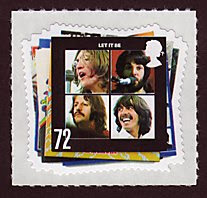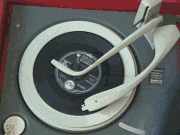


 Royal Mail has issued a set of stamps and souvenir sheet on January 9, 2007 to honor The Beatles’ cultural contribution to British and world music.
Royal Mail has issued a set of stamps and souvenir sheet on January 9, 2007 to honor The Beatles’ cultural contribution to British and world music.British stamps often illustrate British contributions to the world, and The Beatles were certainly known and loved around the world as well as having a lasting effect on popular music and culture. Note: This article was updated after the stamps were issued, so they appear here.
There’s definitely a trend by postal administrations to cash in on popular entertainment. Witness the large number of Harry Potter stamps (issued by France, among others) and the Star Wars stamps offered by the US Postal Service. Royal Mail is joining the crowd with this Beatles issue. These are commemoratives stamps, as we call them in the US, and so to have any justification at all, they need to commemorate something. In this case, it is the first meeting of John Lennon and Paul McCartney in 1957, a nice, round 50 years ago. A flimsy reason, but, from Royal Mail’s viewpoint, better than waiting for the 50th anniversary of their first number one single, which will be in 2012 or thereabouts.
The issue consists of six self-adhesive stamps plus a souvenir sheet containg four stamps with water-activated gum. (What, no prestige booklet with glossy color photos from the 60s? How did Royal Mail miss such an opportunity?) Each of the six stamps pictures a stack of record albums, slightly misaligned so that portions of the ones underneath the top ones are visible. The innovation of these stamps is that the edges of the stamps follow the border of the piles of albums. Each stamp has a different edge.
 The albums are:
The albums are:“With The Beatles” — 1963
“Help” — 1965
“Revolver” — 1966
“Sgt. Pepper's Lonely Hearts Club Band” — 1967
“Abbey Road” — 1969
“Let It Be” — 1970
 The four first-class non-denominated stamps in the souvenir sheet picture various items of Beatles memorabilia. The stamps highlight a toy guitar, a lunchbox, a 45 rpm single (a record with one song on each side) and a tea tray. Other items are also visible on the stamp and in the margin. The souvenir sheet and a set of the six stamps are optionally available in a presentation pack, an illustrated cardboard folder with information about the stamps. The section of the presentation pack that holds the souvenir sheet in a clear plastic pocket also features memorabilia, and the souvenir sheet is the same design as part of the section. When the souvenir sheet is placed in the pack, it almost exactly overlays the illustration underneath. Let me show you what I mean.
The four first-class non-denominated stamps in the souvenir sheet picture various items of Beatles memorabilia. The stamps highlight a toy guitar, a lunchbox, a 45 rpm single (a record with one song on each side) and a tea tray. Other items are also visible on the stamp and in the margin. The souvenir sheet and a set of the six stamps are optionally available in a presentation pack, an illustrated cardboard folder with information about the stamps. The section of the presentation pack that holds the souvenir sheet in a clear plastic pocket also features memorabilia, and the souvenir sheet is the same design as part of the section. When the souvenir sheet is placed in the pack, it almost exactly overlays the illustration underneath. Let me show you what I mean.Below is the section of the presentation pack without the souvenir sheet. The gray shading over the bottom two-thirds of it is the clear plastic pocket to hold the souvenir sheet.
 Now here’s the presentation pack with the souvenir sheet tucked in. You can see the perforations around the stamps and the Queen’s head and service indicator on each stamp. The designs on the sheet and the pack don’t quite line up — look at the harmonica at the lower left corner of the souvenir sheet. Still, it’s a pretty neat effect.
Now here’s the presentation pack with the souvenir sheet tucked in. You can see the perforations around the stamps and the Queen’s head and service indicator on each stamp. The designs on the sheet and the pack don’t quite line up — look at the harmonica at the lower left corner of the souvenir sheet. Still, it’s a pretty neat effect. Here’s the souvenir sheet by itself.
Here’s the souvenir sheet by itself. This is a ground-breaking issue in that it prominently features two living people who are not members of the Royal family. In 2002, Royal Mail revised its criteria for special, or commemorative, stamps. The criteria included several conventions, one of which is “Members of the Royal family are the only identifiable living people who may be the ‘hero image’ on a stamp.” There are some exceptions, including “when their achievement is the focus of the design rather than their image.”
This is a ground-breaking issue in that it prominently features two living people who are not members of the Royal family. In 2002, Royal Mail revised its criteria for special, or commemorative, stamps. The criteria included several conventions, one of which is “Members of the Royal family are the only identifiable living people who may be the ‘hero image’ on a stamp.” There are some exceptions, including “when their achievement is the focus of the design rather than their image.”Royal Mail hasn’t said much about this. They seem to be including this issue within that exception by saying that the issue celebrates “the Beatles [sic] extraordinary cultural contribution to this country,” implying that it is not the band members themselves who are being honored. It is likely that no one at Royal Mail who is currently responsible for new stamps remembers that this is very similar to the justification used in 1964 to picture Shakespeare on a set of stamps. At that time, the rule was that only members of the Royal family could be pictured on stamps, period. No one else. The rationale used at that time was that the issue commemorated the Shakespeare Festival held that year, not the Bard himself. Also, the Queen’s portrait was the same size as Shakespeare’s. A year later, the rule was totally discarded with the issue that directly honored Winston Churchill.































No comments:
Post a Comment